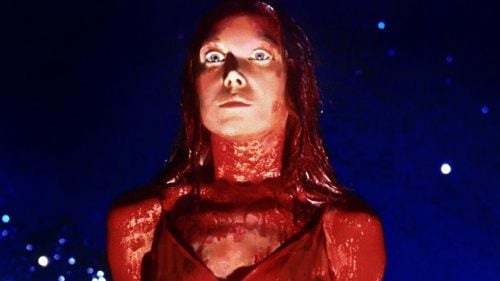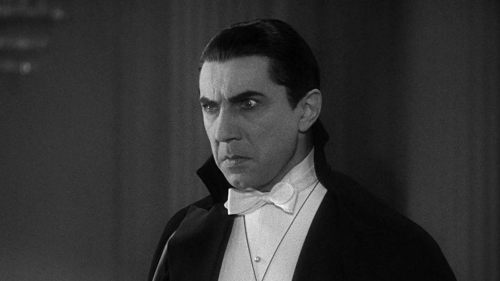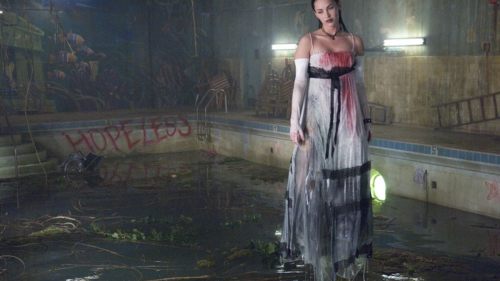DESTROYER Director Karyn Kusama Talks Nicole Kidman’s Transformative Turn And “Sunshine Noir”
A lot of the early line on Destroyer, which opened in New York and Los Angeles on Tuesday and expands in January, has focused on the deglamorization Nicole Kidman underwent for the role of deeply troubled LAPD detective Erin Bell. It is indeed an attention-grabbing physical transformation, but now that the movie is in theaters, director Karyn Kusama hopes Kidman’s deeply felt emotional performance will receive just as much notice.
“That’s something Nicole and I like to remind people of—that [the makeup is] just one component of this character, and the external one at that,” Kusama says. “What makes it so profound to me is the sense that on some truly spiritual level, this woman has decayed and deteriorated, and we are witnessing that deterioration before our eyes. It’s in the sound of her voice, it’s in her affect, it’s in her walk, and it’s in the way she looks at the world. And I hope that those come through as strongly as the other factors do.”
Kidman does indeed plumb heretofore unexplored depths of dissolution as Bell, a psychological and physical wreck who is forced to confront the tragedy that led her to that place when a gang leader from her past resurfaces. The fact that this is not a typical role for the actress (also on screen this month in Aquaman) was part of what attracted her to it, and Kusama to this collaboration. “We had quite literally just started the casting process when Nicole, independent of that, read the script and reached out to us to put her hat in the ring,” the director recalls. “I have to say, after our first conversation, I didn’t need to look any further. While she may have been an unlikely choice at the beginning, she ultimately had this sort of gravitational pull toward the material. Of course, over the years, we’ve seen her incredible skill and soulfulness as an actor, and so the fact that she was openly kind of terrified of the role, yet couldn’t let go of it, made me feel like she was the artist I wanted to work with.”
Bell is the kind of blunt and hardly sympathetic protagonist that strikes fear in the hearts of studio executives as well, but Kusama found receptive backers in new production outfit 30West, with whom she hooked up following her much-praised horror film The Invitation. “We were lucky; we were the first movie 30West fully financed, and I think they loved Bell’s unsentimentality, her lack of conventional likability or relatability, and they found other reasons to relate to her or root for her. It was useful for us to become involved with that kind of company so early, because we never had to confront the question of whether or not she was likable. It didn’t really matter, and that was a super-exciting way to work: to not be thinking in a defensive mode, but be thinking in a more proactive way about the work itself.”
Two more key creative partners in the Destroyer process were screenwriters Phil Hay (to whom she’s married) and Matt Manfredi, who also scripted The Invitation and Kusama’s previous Æon Flux, which fell victim to severe studio interference. “They appreciate a lot of the same films I do,” she notes, “and they believe in the power of genre to communicate profound and difficult cultural ideas. They share with me a sense of wanting to simply make work that’s satisfying to us, as opposed to checking boxes in some sort of career strategy. I also just believe they’re two of the most skillful writers I know. They’re able to write with a kind of economy that is so rare to experience as a director, when you’re reading work that’s not your own—and trust me, my work has very little efficiency when I’m writing for myself. Their ability to distill a scene, a vibe, a tone, a character, into as few words as possible is so useful for a director. It allows for clarity, but also a sense of openness, to be able to add my own flourishes.”
Part of Kusama’s approach that makes Destroyer distinctive is its sun-blasted visual scheme. It’s a change of pace for cinematographer Julie Kirkwood (who previously brought threatening darkness to fright fare like Osgood Perkins’ The Blackcoat’s Daughter and Bryan Bertino’s The Monster), and also runs counter to the typical look employed for stories of crime and broken souls, which tend to play out in film-noir nighttime and shadows. “The script kind of demanded this ‘sunshine noir’ approach, a brutal use of daylight, working against a more mysterious nighttime palette,” Kusama says. “Los Angeles is an environment that offers what starts to feel like relentless sunshine. It’s almost like this brightness in the sky you cannot avoid, and that felt very metaphorical to my main character’s crisis, which is one of self and of personal ethics, and is born out of her denial and her unwillingness to look at herself in a concentrated way. To me, there’s something about the sunshine of LA that has this very double-edged-sword quality.”
The setting offered a further advantage, she explains: “LA is such an incredibly sprawling and diverse city, and I don’t think we get to see how diverse it is in movies. There was something in the saga of her odyssey across LA that gave me a lot of opportunities to dig into corners of the city that I don’t think we normally see on film.”
Kusama and her team had just 33 days to capture that sprawling narrative, which was quite a switch from The Invitation, whose action is set almost entirely in one house. “There’s something completely different about the adventure of landing in a new location pretty much every single day of your shoot, and sometimes heading to a second or even a third on certain incredibly difficult days. The confinement to one location that we had on The Invitation created a real purity of process among the actors—every single day was essentially a step towards realizing the story of that evening—whereas Destroyer demanded a different kind of focus.”
That was particularly true of the movie’s most complex setpiece, in which Bell interrupts a bank heist. “That scene absolutely had to be highly planned and organized. For all the driving to and from, all the stuff that happens in the lobby and the inside of the bank, and the foot chase, we only had four days—and Nicole had the flu! So it was very, very challenging. I had made the decision early on that I didn’t want to use CGI, and so we were always working with live fire. While that, on the one hand, gives the actors so much more to work with, it puts the crew and cast on a much more anxious edge while you’re working, because it’s loud and smoky and jarring to have submachine guns constantly going off. That was an intense week [laughs]!”
This sequence in particular and Destroyer in general have the feel of the great, lowdown crime thrillers of the 1970s, much as The Invitation carried echoes of Rosemary’s Baby and other mood-oriented horror films of the ’60s and ’70s. Kusama, who is reteaming with Hay and Manfredi on an adaptation of Chase Novak’s domestic-horror novel Breed for Fox and an indie she calls “the third installment of our LA trilogy,” and is also developing a TV project based on Mary Gaitskill’s short-story collection Bad Behavior, says, “I don’t know if I consciously try to evoke [those older movies] in my own work, but they are the films that have taught me so much about cinematic storytelling. They’ve taught me about the value of restraint, of not seeing everything or explaining everything, and so they and their makers are kind of like spiritual guides for me. I find myself returning to them for inspiration, and just for the sense of comfort that there was a time when even big-studio movies were smart and mysterious—that there was a way to be both. That’s what I hope to be able to carve out for myself in today’s modern movie space—a slot of filmmaking that doesn’t pander to the audience, and has a sense of its own personal philosophy, but that also works on an entertainment level.”



